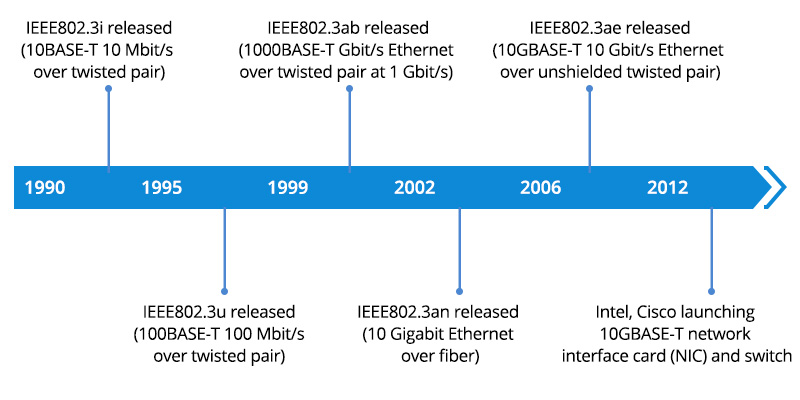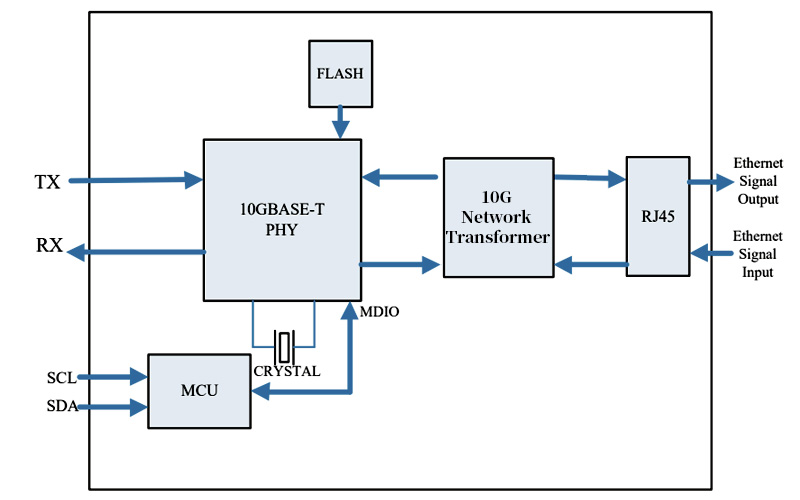10GBASE-T Ultimate Guide - Introduction, Cable, Pros and Cons
10GBASE-T Introduction
10GBASE-T is a local area network (LAN) connection technology applied in 10 Gigabit Ethernet. Using unshielded twisted pair (UTP) copper cable as transmission medium, 10GBASE-T SFP+ transceiver supports a data rate of 10Gbps/s at a link distance up to 100 meters over Cat6A twisted copper cable.

QSFPTEK 10GBASE-T Copper RJ45 SFP+ Transceiver
Arrival of 10GBASE-T
In 2002, the Institute of Electrical and Electronics Engineers (IEEE) released the 10 Gigabit Ethernet over fiber standard IEEE802.3ae. After that, based on optical fiber networks, 10 Gigabit data centers are constructed quickly and massively. On the other hand, because of the limitation of technology at that time and the bandwidth of copper cable, 10 Gigabit Ethernet 10GBASE-T technology couldn't be realized. However, the exploration of it was never stopped since the copper cable system has superior advantages in price and flexibility in short-range applications. Finally, in 2006, IEEE 802.3an standard was released to provide 10 Gbit/s speed connections over unshielded twisted pair copper cables, supporting distance up to 100 meters over Category 6A (Cat6A). And in 2012, Intel and Cisco launched a 10GBASE-T switch and network interface card (NIC), which indicates 10GBASE-T technology was applied to practice.

Development of Ethernet technology based on twisted pair
How 10GBASE-T SFP+ Transceiver Works
10GBASE-T SFP+ transceiver is also known as the 10G copper RJ45 transceiver with interfacing an RJ45 port. Through this RJ45 port, 10 Gigabit differential signals are input into the SFP+ copper transceiver over the Cat6A cable. And then the inputted signals will experience filter and shaping to ensure the signals are complete and clean when inputting to the physical layer (PHY). Finally, the signals output after data decoding in PHY. The working diagram of the SFP+ RJ45 copper transceiver is as follows.

10GBASE-T RJ45 SFP+ transceiver working diagram
Copper twisted-pair-based Ethernet technology standard was first released in 1990, which defined 10BASE-T over twisted pair at the speed of 10 Mbit/s. After two decades, the twisted pair Ethernet has evolved from 10BASE-T to 100BASE-T to 1000BASE-T and now to 10GBASE-T. Compared to its predecessors, 10GBASE-T uses more complicated pulse-amplitude modulation of PAM-16 and Tomlinson-Harashima precoding (THP) to achieve 10 Gbps throughput. The technical differences between 10GBASE-T, 1000BASE-T, and 100BASE-T are shown in the following table.
100BASE-T vs 1000BASE-T vs 10GBASE-T
Advantages of 10GBASE-T
Auto-negotiate and Backward Compatible. 10GBASE-T offers immense flexibility with its auto-negotiate function. It supports backward compatibility and interoperation with existing 1Gbps or 100Mbps Ethernet networks. This means you could gradually increase expenditure during upgrading your data center to 10 Gbps instead of upgrading all servers and switches to 10Gb/s on a large scale at once.
Low Cost. Compared to the 10G SFP+ fiber system, the SFP+ copper system offers a lower cost for the copper transmission media is much cheaper than fiber media.
Challenge of 10GBASE-T
With the advantages of low cost and flexibility, the copper twisted-pair-based 10GBASE-T cabling system has quickly seized part of the market previously occupied by 10 Gigabit optical fibers. However, there are also challenges for it.
External Crosstalk
To increase the transmission data rate to 10 Gigabit, Cat6A cables are required to reach 500 MHz frequency. The transmission performance is sensitive to external crosstalk in such a high frequency. What is external crosstalk? In equipment rooms or offices, various wires are generally tied up and placed in a slot. One of the wire pairs will be disturbed by others in the same bundle of wires. That is external crosstalk. The following picture shows the crosstalk of one cable caused by surrounding cables.

Crosstalk caused by surrounding different cables
Power Consumption
Compared to fiber-based SFP+ transceivers, 10GBASE-T transceivers require a higher power consumption. The max power consumption of a 10GBASE SR SFP+ optical transceiver is only 0.8W, while the 10G copper transceiver is 2.5W. So it may appear to be cheaper on a copper cable basis, but the power consumption needed to support 10G copper RJ45 over Cat6A is tremendous compared to Optics.
10GBASE-T Cable Guide
The above introduction has told the max transmission distance of the 10GBASE-T copper transceiver is 100 meters over Cat6A. How about Cat5e, Cat6, or Cat7? Can they work on 10GBASE-T SFP+ to achieve a speed of 10Gbps? Which one is more suitable for 10G networks?
Cat6 is also capable of a 10Gbps data rate, however, the transmission distance is
limited to 55 meters, which is shorter than Cat6A.
Same as Cat6A, Cat7 supports 10Gbps at a distance of up to 100 meters. However, since using a double-layer shielding, the wire diameter Cat7 is much larger than Cat6A. So Cat7 takes up more space and also brings inconvenience to cabling. Moreover, the connector of Cat7 is special GG45 or TERA instead of common RJ45, thus the compatibility is not as good as Cat6A.
As for Cat5A, it is disappointing to note that 10G copper transceivers can't properly work over Cat5A at a speed of 10Gbps. If you have to connect Cat5A with the SFP+ copper Rj45 transceiver, the transceiver may auto-negotiate to 1000Mbps. However, Cat6A is cheap, so why not directly upgrade your Cat5A to Cat6 to enjoy better network performance?
In summary, Cat6A is the best option for 10GBASE-T cabling.
Learn more about the differences between Cat5e, Cat6, Cat6A, and Cat7.
QSFPTEK provides cost-effective and high-performance 10GBASE-T SFP+ transceivers, supporting links up to 30 meters over Cat6A or Cat7 at a low power consumption of less than 2.5W and the BER ( Bit Error Rate) is below 10^-12. QSFPTEK 10G copper transceivers are widely compatible with almost all original equipment manufacturers 10GBASE-T switches, NICs, and servers, like Cisco, Juniper, Arista, Intel, HPE, etc. Welcome to consult via [email protected].











